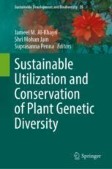Search
Search Results
-
Toward Drought Tolerance in Tomato: Selection of F2BC1 Plants Obtained from Crosses Between Wild and Commercial Genotypes
The tomato plant ( Solanum lycopersicum L.) demands more water than other vegetables. However, water availability has become a limiting factor...

-
Effects of grafting with wild tomato (Solanum pimpinellifolium and Solanum habrochaites) rootstocks on growth and leaf mineral accumulation in salt stress
The positive response of grafting by tolerant rootstocks or scion-stock interactions on yield and fruit traits of tomatoes under saline conditions is...

-
Sustainable Utilization of Wild Germplasm Resources
Breeders have received a number of “game-changing” features or genes from crop wild relatives (CWRs), which have increased crop resilience and...
-
Differential defensive and nutritional traits among cultivated tomato and its wild relatives shape their interactions with a specialist herbivore
Main conclusionCultivated tomato presented lower constitutive volatiles, reduced morphological and chemical defenses, and increased leaf nutritional...

-
Pollination by Wild and Managed Animal Vectors
In this chapter, we first document the present knowledge of wild and managed pollinators in Mexico. We reviewed literature of wild pollinators (e.g.,...
-
Field evaluation of CRISPR-Cas9-driven brachytic and jointless pedicel tomatoes identifies an association between the high extra-large-sized fruit yield of the brachytic-mediated shortened tomato and the jointless2
Fresh-market tomato is one of the most important vegetables in the United States (US), and novel, cost-effective labor solutions are an important...

-
Utilization of Wild Food Plants for Crop Improvement Programs
Crop wild relatives or wild plants related to domesticated crops are potential resources for crop improvement. They can be landraces, crop...
-
First report of tomato chlorosis virus (ToCV) and detection of other viruses in field-grown tomatoes in North-Western region of India
Tomato crop is known to be infected by large number of viruses across the globe causing severe losses in its yield. Accurate information on the...

-
Resistance, hybrid vigor, genetic diversity, and toxicity of chemical constituents of tomatoes to Tuta absoluta (Lepidoptera: Gelechiidae)
Plants employ defense strategies to reduce or prevent attacks by phytophagous insects and survive. These strategies can involve chemical constituents...

-
Conservation of Wild Food Plants and Crop Wild Relatives: Planning, Strategies, Priorities, and Legal Frameworks
Wild food plants (WFPs) are nutritionally rich and are consumed by the indigenous communities whereas crop wild relatives (CWRs) are the wild...
-
Wild, Weedy and Domesticated Plants for Food Security and Sovereignty
Archaeological studies have revealed that humans have inhabited the territory that today is Mexico for more than 20,000 years, while ethnobotanical...
-
Nutritional Potential of Wild Edible Rose Hips in India for Food Security
Wild fruits possess important bioactive chemicals that may prove useful in alleviating several health ailments. In many places around the world, wild...
-
How is leaf herbivory related to agriculture? Insights from the Mexican center of crop origin
Although insect herbivory is thought to be higher in agroecosystems compared to natural ecosystems, direct evidence on how agriculture itself has...

-
Distinct Phyllosphere Microbiome of Wild Tomato Species in Central Peru upon Dysbiosis
Plants are colonized by myriads of microbes across kingdoms, which affect host development, fitness, and reproduction. Hence, plant microbiomes have...

-
Biofortified tomatoes provide a new route to vitamin D sufficiency
Poor vitamin D status is a global health problem; insufficiency underpins higher risk of cancer, neurocognitive decline and all-cause mortality. Most...

-
Identification of new sources of heat tolerance in cultivated and wild tomatoes
Heat stress adversely affects tomato production worldwide. Breeding thermotolerant varieties is critical to adapt to increased heat stress but tomato...

-
Wild strawberry Fragaria vesca as potential source for phytonematode resistance
Phytonematode infections are a major constraint to agriculture and can cause pre-harvest losses of up to one-third of the crop in affected fields....

-
Efficient Regeneration and Agrobacterium-Mediated Transformation Method For Cultivated and Wild Tomato
Agrobacterium -based stable transformation is an imperative tool for functional genomics studies and crop improvement which is needed to maximize the...

-
Antioxidant, Antimicrobial, and Antiproliferative Activities of Some Edible Wild Mushrooms
AbstractEdible mushrooms are dietary products that are widely consumed in many societies. It is known that mushrooms, which stand out with their...

-
Conservation and Use of Plant Genetic Resources in Papaya with a Focus on Wild Resources
Papaya is one among the most important tropical fruit crops cultivated in the tropical and subtropical regions of the world for its nutritional,...
